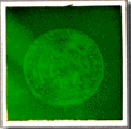Light & Optics Supplementary Module: Holograms
Steve Beeson, Arizona State University

When we saw the image created by the hologram, we were actually looking at only one of two images the hologram was producing. When illuminated with the reference
beam, the hologram produces both a real and a virtual image. (If you need to catch up on real and virtual images, go back to Submodule 2) So not only can you see the image from the hologram, you can also project it onto paper or onto the wall.
If we wish to make a hologram to see in regular white light, we need to use the real image of our standard hologram (called a transmission hologram). The real image is first passed through a narrow slit and then recorded on a second photographic film. The slit acts to diffract the incoming image into different wavelengths. The second photographic film then records the diffracted image, essentially many separate images of the slit.
If we then develop this second photograph and shine white light onto it, the image produced is a composite of images of the slit, in different colors (wavelengths).
 Modules
Modules
 Light & Optics
Light & Optics
 Supplementary
Supplementary
 Readings
Readings
 PiN Homepage
PiN Homepage
 ACEPT
ACEPT
 Glossary
Glossary
 Help
Help